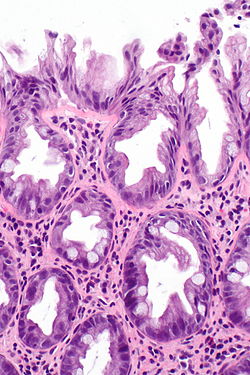Serrated polyposis syndrome
(Redirected from Hyperplastic polyposis syndrome)
Jump to navigation
Jump to search

Micrograph showing the serrations of a hyperplastic polyp as may be seen in serrated polyposis syndrome.
Serrated polyposis syndrome, previously known as hyperplastic polyposis syndrome, is an uncommon condition characterized by the presence of serrated (colonic) polyps (hyperplastic polyps, sessile serrated adenomas), probably represents several distinct pathologies and is associated with an increased risk of colorectal carcinoma.[1]
No specific gene mutation for the syndrome is identified as of 2012.[2]
WHO definition
One of the following three:[2][3]
- >=Five hyperplastic polyps proximal to the sigmoid colon with two of the five >=10 mm.
- One hyperplastic polyp proximal to the sigmoid colon, in someone with a first degree relative with the syndrome.
- >20 hyperplastic polyps through-out the colon, i.e. not all can be rectal polyps.
See also
References
- ↑ Huang, CS.; Farraye, FA.; Yang, S.; O'Brien, MJ. (Feb 2011). "The clinical significance of serrated polyps.". Am J Gastroenterol 106 (2): 229-40; quiz 241. doi:10.1038/ajg.2010.429. PMID 21045813.
- ↑ 2.0 2.1 Rex, DK.; Ahnen, DJ.; Baron, JA.; Batts, KP.; Burke, CA.; Burt, RW.; Goldblum, JR.; Guillem, JG. et al. (Sep 2012). "Serrated lesions of the colorectum: review and recommendations from an expert panel.". Am J Gastroenterol 107 (9): 1315-29; quiz 1314, 1330. doi:10.1038/ajg.2012.161. PMID 22710576.
- ↑ Rosty, C.; Parry, S.; Young, JP. (2011). "Serrated polyposis: an enigmatic model of colorectal cancer predisposition.". Patholog Res Int 2011: 157073. doi:10.4061/2011/157073. PMID 21660283.